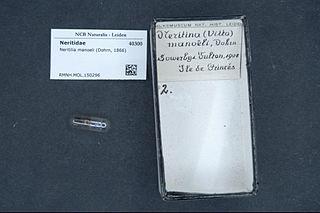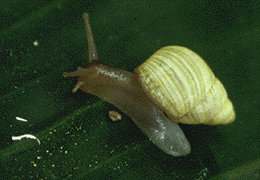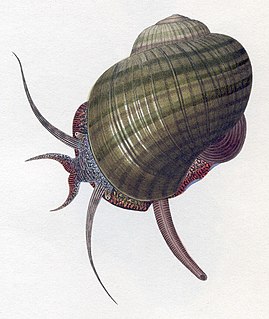
Euhadra is a genus of air-breathing land snails, terrestrial pulmonate gastropod mollusks in the subfamily Bradybaeninae of the family Camaenidae.
Caseolus calculus is a species of small air-breathing land snails, terrestrial pulmonate gastropod mollusks in the family Hygromiidae, the hairy snails and their allies.
Fluvidona anodonta is a species of minute freshwater snail with an operculum, an aquatic gastropod mollusk or micromollusk in the family Hydrobiidae.
The Moapa pebblesnail also known as the Muddy Valley turban snail, scientific name Pyrgulopsis avernalis, is a species of small freshwater snail with an operculum, an aquatic gastropod mollusk in the family Hydrobiidae.

Neritilia manoeli is a species of minute freshwater snail with an operculum, an aquatic gastropod mollusk or micromollusk in the family Neritiliidae.
Pseudocampylaea is a genus of air-breathing land snails, terrestrial pulmonate gastropod mollusks in the family Hygromiidae, the hairy snails and their allies.
The thick-lipped pebblesnail, scientific name Somatogyrus crassilabris, was a species of freshwater snail with an operculum, an aquatic gastropod mollusk in the family Hydrobiidae, the mud snails. This species was endemic to the United States. Its natural habitat was rivers. It is now extinct.
Trochulus caelatus is a species of small, air-breathing land snail, a terrestrial pulmonate gastropod mollusk in the family Hygromiidae, the hairy snails and their allies.

Partula is a genus of air-breathing tropical land snails, terrestrial pulmonate gastropod mollusks in the family Partulidae. Many species of Partula are known under the general common names "Polynesian tree snail" and "Moorean viviparous tree snail". Partulids are distributed across 5,000 sq mi (13,000 km2) of Pacific Ocean islands, from the Society Islands to New Guinea.

Xerosecta cespitum is a species of small air-breathing land snail, a terrestrial pulmonate gastropod mollusk in the family Geomitridae, the hairy snails and their allies.

Pomacea paludosa, common name the Florida applesnail, is a species of freshwater snail with an operculum, an aquatic gastropod mollusk in the family Ampullariidae, the apple snails.

Lanistes ovum is a species of freshwater snail with an operculum, an African apple snail, an aquatic gastropod mollusk in the family Ampullariidae.

Paludomidae, common name paludomids, is a family of freshwater snails, gastropod molluscs in the clade Sorbeoconcha.
The western falanouc is a rare mongoose-like mammal endemic to Madagascar. Until recently, the eastern falanouc was the only recognized species in the genus Eupleres. In 2010, Goodman and Helgen provided morphological evidence showing the two falanoucs are each a separate species and are found in separate geographical locations. E. major is larger and browner compared to E. goudotii and has a diet consisting mainly of invertebrates such as worms, snails, and slugs.
Geomitridae is a taxonomic family of small to medium-sized air-breathing land snails, terrestrial pulmonate gastropod mollusks in the superfamily Helicoidea.







